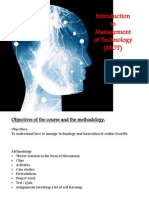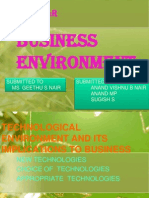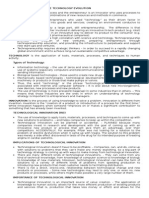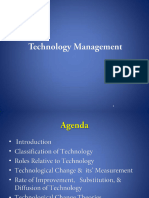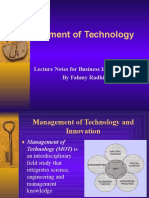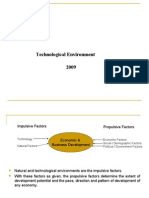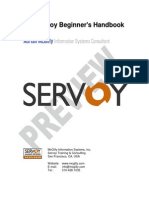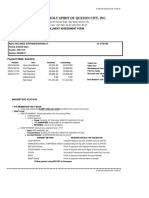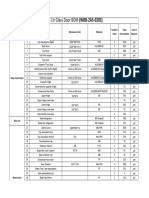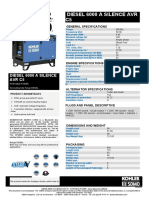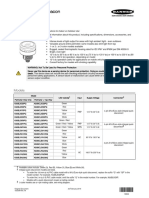Introduction and Framework : Session 1 Defining Innovation
Defining technology
Type Definition Example Definition Definition Examples
Technology is the Type
Instrumental application of scientific Wheel, antibiotics, GPS Introduction of a good or 1. Introduction of the iPhone
Definition knowledge for practical Product service that is new or 2. in 2007. Electric cars like
purposes, especially in Innovation significantly improved in terms 3. Tesla.
industry. of its characteristics or Streaming services like Netflix.
intended use.
Technology is a system that Implementation of a new or 1. Toyota's "Just-In-Time"
Social media,
Socio-Cultural uses Process significantly improved 2. manufacturing. Amazon's use
online education Innovation production or delivery 3. of drones for delivery. Online
Definition knowledge, skills, and
resources to meet human portals, fitness method. check-in services in airlines.
needs and extend human trackers Introduction of new 1. Google's 20% time policy.
abilities. organizational
Organizational methods in the firm's business 2. Agile methodology in software
Technology is the process
practices,
Process-Oriented by which humans convert Renewable energy Innovation workplace organization, or development.
Definition inputs into outputs to meet external
their needs and wants. relations. 3. Open-source development
models.
�Relationship – technology and innovation Technology is omnipresent
• Technology and individual
• Technology as an Enabler: For example, the Internet
• Technology and business
technology enabled innovations like e-commerce and
• Technology and government
social media platforms.
• Technology and society
• Innovation as a Driver: Innovations in battery technology
have driven advancements in electric vehicles. • Businesses use technology to automate their business
• Co-Evolution: The development of machine learning processes That goes into their products and services
algorithms (technology) has led to innovative • Governments use technology to Manage national
applications like autonomous vehicles, which in turn resources – water, electricity, environment & Provide
push the boundaries of technology further. national security
• People (societies) use technology to improve quality of their
lives
• Governments of developed states now recognize
management of technology as a high priority area and one of
the most important factors in industrial regeneration,
economic development and international competitiveness.
�What value you expect technology to Technological impact on business is pervasive
add to individuals’ life? • Operational Efficiency • Cybersecurity
• Automation of routine tasks • Data encryption and secure transactions
• Makes life easy
• Streamlined supply chain management • Firewall and antivirus solutions
• Save effort - machines do labor- • Improved resource allocation • Compliance with data protection regulations
intensive jobs • Customer Experience • Employee Productivity and Well-being
• Save time - do things faster and • Personalized marketing • Remote work capabilities
better • Enhanced customer service through AI chatbots • Employee monitoring software
• Greater emotional satisfaction – • E-commerce and online shopping platforms • Wellness apps and platforms
look good, look smart, • Data-Driven Decision Making • Sustainability
• Advanced analytics for market research • Energy-efficient technologies
• Makes life more fulfilling • Real-time data for performance metrics • Waste management solutions
• Have more time for things you • Predictive analytics for future trends • Sustainable sourcing through blockchain
really love / want to do • Innovation and Product Development • Financial Management
• More time for leisure activities • Rapid prototyping through 3D printing • Automated invoicing and payroll
• Open innovation platforms • Real-time financial analytics
• More time / opportunity to connect
• Accelerated R&D through simulation software • Risk assessment algorithms
with friends • Globalization • Strategic Positioning
• Virtual teams and remote work • Technology as a competitive advantage
• Global market access through e-commerce • Digital transformation strategies
• Real-time translation services • Technology partnerships and alliances
� Tech classification of industry based on R&D Tech characteristics
investment
• High-tech • Low-tech
Classification Example Industries Example Typical R&D • Emerging and growth • Matured industries –
Companies Intensity sectors established players and
Pharmaceuticals,
High-Tech Semiconductor Pfizer, Intel, > 5% • Innovation is source of market shares
Industries Manufacturing, Software Google competitive advantage • Size is the source of
Development competitive advantage
• High profit margin
Medium-Tech Automotive Manufacturing, Ford, Dow 3% - 5% • High rate of innovation • Low profit margin
Industries Chemical Manufacturing
• High R&D investments > 5% • Low rate of innovation
Medium- • High skill requirement – • Low R&D investments < 1%
Textile Manufacturing,
Low-Tech Food Processing
Nestlé, Unilever 0.9% - 3% knowledge work • Lower skill requirements –
Industries • Example: software, labor work
Low-Tech Cement Manufacturing, Lafarge Holcim, biotechnology, internet, • Examples: traditional
Paper Manufacturing, Metal International pharmaceuticals
Industries < 0.9% industries like cement,
Products Manufacturing Paper, Nucor
paper, food, chemicals, bulk
drugs, metals
�Technology and Society
Summary
Criteria Individuals Businesses Nations Society
Convenience,
Efficiency, Governance, Social cohesion,
Why They entertainment,
competitiveness, security, economic public services,
Use personal growth,
customer development. cultural
Technology communication.
engagement. preservation.
Time-saving, Profit National security, Social welfare,
Value Sought personal well- maximization, public welfare, equality,
being, skill market share, global standing. cultural
development. innovation. enrichment.
Technology and Ethics - Human Values and Technology Data privacy, Cybersecurity, Cyber warfare,
Example: Facial recognition technology raises ethical concerns about privacy and potential Technology Digital divide,
screen addiction, data tech policy,
misuse by authorities. Management ethical norms,
skill obsolescence. management, infrastructure.
Issues societal risks.
Sustainable Technology - Protecting the Planet tech adoption.
Example: Solar panels and wind turbines reduce reliance on fossil fuels, helping mitigate
climate change.
Societal Impacts of Technology
Example: Social media platforms have been linked to issues like cyberbullying and the spread
of misinformation.
Universal Access to Technology
Example: Low-cost internet programs bridge the digital divide, promoting universal
technology access in underprivileged communities.
�Technology Management
• TM is the systematic approach to planning, developing, and implementing technological capabilities to shape and accomplish the strategic and operational objectives
of an organization.
• Example: For instance, Apple Inc. uses TM to manage its technological innovations, from the development of the iPhone to its operating system, to maintain its market
leadership.
Competitive Advantage:
- Google: Advanced search algorithm (80% online search market share)
Need for managing technology and innovation - Walmart: Efficient supply chain management (Low-cost retailing)
- Amazon: Integrated tech stack, one-click ordering, personalized recommendations (Top online retailer)
- China: Advanced manufacturing technology (World's factory, global economic power)
Aspect Why Technology Must Be Managed - India: UPI technology (Emerging global role in financial tech)
Strategic Align technology with business goals. Alignment with Business Goals:
Importance - Amazon: Technology aligned with customer-centric goal (One-click ordering, personalized
recommendations)
Resource Optimize financial, human, and time resources - Netflix: Data analytics and ML for personalized entertainment (Enhanced customer retention)
Management to maximize ROI Resource Optimization:
- Toyota: Just-In-Time system for resource optimization
Identify assess, and prioritize risks in - Google: Advanced algorithms for energy usage optimization (Millions of dollars in annual savings)
Risk Mitigation
technology projects to reduce its adverse Risk Mitigation:
effect - JPMorgan Chase: $600M annual investment in cybersecurity
Cultural Creates an environment conducive to - Mayo Clinic: Dedicated team for continuous monitoring and updating of medical technology
Implications technological innovation. Cultural Implications:
- Importance: Cultural impact on tech adoption, utilization, and success
- Example: Hierarchical culture may resist collaborative tools; innovative culture embraces tech for a
competitive edge.
�Six questions that firms must
answer to realize full potential of Levels of Technology
technology investments Management
Extension of Gregory's five-process model:
• How do we identify technology that will have a future
• Corporate level: how to manage technology across a
impact on our business?
diverse range of businesses
• How do we select technology for business benefit?
• Business level: how to gain competitive advantage
• How should we acquire new technology? through technology
• How do we exploit our technology assets? • Operational level: how to optimise internal processes
• How can we protect our technology assets? to manage technology effectively
• How can we learn from our experience to improve our
ability to develop and exploit the value of technology?
�Strategic technology Operational technology
management management
Management of research and new product and process
development and focuses on ensuring effective deployment of
• Technology Strategy Development internal technical resources to realize the desired competitive
• Technology Portfolio Selection advantage
• Technology Road-mapping Activities:
• Make or Buy • Project Selectionand Evaluation
• Product Platform Development • Resource Allocation
• Licensing and Patent Protection • Technology Transfer and Assimilation
• Management and Introduction of New
Products and Processes
� Global technology management
• How to gain access to technology? • Global markets necessitate effective Challenges
organization and management of
• How many R&D centres to have,
technology development across • Consumer behavior and technology are
located where and with what
diverse sites and for various
funding structure?
businesses.
changing fast
• How to balance the need for both • The intricate relationship between • Technology gets obsolete very fast
long-term investments and short- business, markets, and technology • Forecasting consumer behavior
term returns? is prompting companies to reassess • Forecasting technology evolution
• How to speed up development and key factors such as:
improve communication and • Scale, location, and nature of R&D • Budgeting for new technology
technology transfer between facilities • Overcoming / winning patent wars
centres and businesses using the • Utilization of external alliances to • Makes powerful more powerful
technologies? mitigate rising costs and risks in
technology development
• Displacement of traditional jobs
• Identification of comprehensive
technological competences
required for maintaining
competitiveness









